Passiflora spp.
Passionflower is arguably one of the most unique specimens of flora on the planet.
Blooms of this vine are flamboyant and complicated, with a large crown of corona filaments reaching from the stamen that make identification easy.
This genus also includes a whopping selection of more than 500 species separated into three main types: purple, yellow, and granadilla (red).
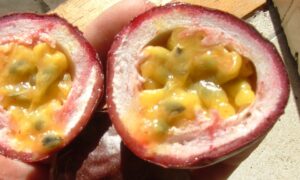
What You’ll Learn
- What Is Passionflower or Passion Fruit?
- Cultivation and History
- Propagation
- How to Grow
- Growing Tips
- Species to Select
- Managing Pests and Disease
- Harvesting
- Preserving and Culinary Use
- Quick Reference Growing Guide
What Is Passionflower or Passion Fruit?
Passionflower is a semi-herbaceous, fruiting vine native to Latin America, but many varieties have been naturalized throughout other regions of the world.
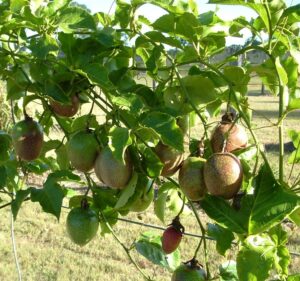
In North America, for example, some varieties can be seen growing wild alongside woodland areas, in thickets, and from disturbed, fertile ground.
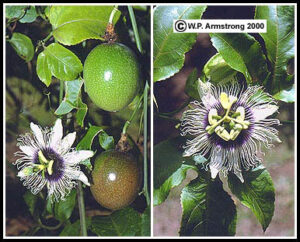
The majority of species in this genus grow best in regions where temperatures do not fall below 32°F.
However, even in areas where temperatures are lower, some varieties of this perennial will not die off entirely if temperatures remain above about 5°F, as the roots are very hardy and can be protected by mulching and covering.
Most successful cultivation occurs in regions where temperatures are between 60 and 90°F throughout the year, such as in USDA Hardiness Zones 9 to 11 in the southern United States.
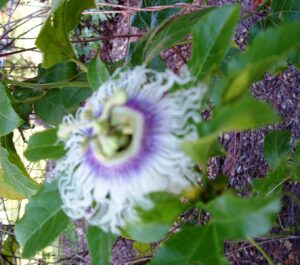
Flowers and fruit grow simultaneously, with blooms from spring through late fall, and fruit produced from May through August, in most regions.
This vine offers a wide range of color variations in its blooms, from pale lavender and blue to flame red and orange, the latter of which can be seen in Passiflora ‘Sunburst.’
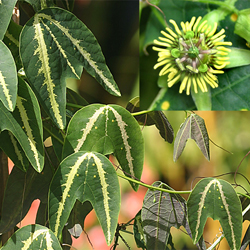
When growing a flowering ornamental, the aroma of its blossoms can be hit or miss, as some stunning plants have a truly horrendous, reeking odor.
Fortunately this is not the case with most types of passionflower, as blossoms generally produce an intoxicating, heady fragrance, such as the gardenia-like scent of the P. mooreana species.
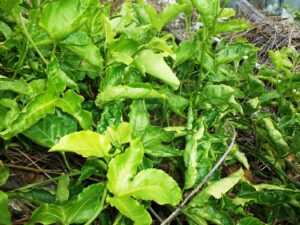
Vines can reach up to 30 feet in length without pruning.
Even though the vines do not require pruning to produce flowers and fruit, they can quickly become overgrown in the home garden under ideal conditions.
Cultivation and History
In the 1500s, Roman Catholics observed the vine growing in parts of Latin America and dubbed it “Passion” after the passion of Christ, in essence, the suffering and death of Christ noted in the Bible.
They believed that parts of the blossoms represented accounts of biblical stories, such as the corona of filaments in the center of each bloom correlating to the crown of thorns worn during the crucifixion of Christ.
Native tribes in North and South America foraged and cultivated the plants for a multitude of uses.
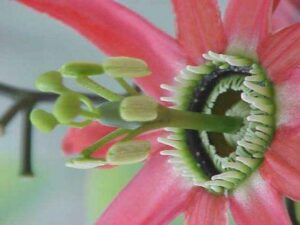
Throughout many cultures, the blossoms, foliage, roots, and fruit are used in herbal medicine. Modern day uses also include flavoring food items, and adding fragrance to perfume and soaps.
While the visual appeal of the blooms is undeniable – many gardeners choose to cultivate passionflower for ornamental purposes – its flowers are highly attractive to pollinators.
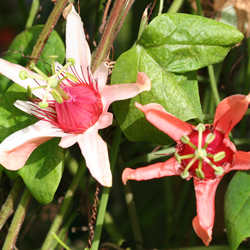
Most varieties of the vines also produce edible passion fruit. However, it’s important to note that not all types produce edible fruits, so consider this when choosing a species or cultivar to suit your needs.
Propagation
Passionflower will thrive with fulfilment of its basic needs. Let’s discuss some of the best methods of propagating this beautiful, useful plant.
From Seed
Fruits of the passionflower vine, called passion fruit, are classified as berries, with a round or oblong shape and tough exterior.
A pulpy sac of up to 300 seeds is contained inside, each one individually surrounded with a slippery membrane.
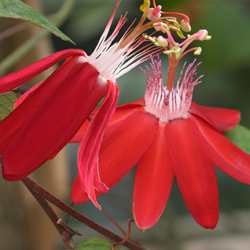
When the fruit has ripened to deep yellow-orange, purple, or red and begun to crinkle on the exterior, the seeds will be ripe for planting.
To increase your chances of successful germination, rub the seeds against a mildly abrasive surface such as a paper towel, a piece of rough fabric, or a bit of screen to break open the membrane surrounding the seed.
Soak seeds in warm water overnight.
While they are soaking, prepare three-inch pots with a handful of compost or seed starting mix. Add one to two seeds to each, planted about one inch deep. Moisten, but do not drench the soil.
Seeds generally germinate within a few days to a week. Seeds that have been allowed to dry out may take longer to germinate, or they may not grow at all.
From Cuttings
Cuttings can take weeks to root. If you are propagating from cuttings, be sure that the parent plant is not grafted onto rootstock, as this can increase the likelihood of developing suckers as plants mature.
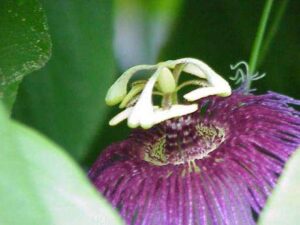
Cuttings taken from grafted stock may produce undesirable results such as poor plant health; stunted or abnormal growth; diminished or absent fruit production; or production of abnormal, inedible fruit.
Suckers appear as shoots that grow from the roots at ground level, and while they may seem useful for starting new vines, suckers are not productive and will not produce fruit, or they may produce fruit that is not edible.
Prepare a pot or tray with three parts builder’s sand to one part soil. Coarse industrial silica sand generally works best, as it allows for good drainage.
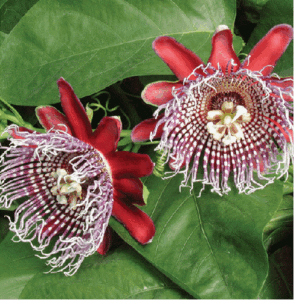
Choose a segment of about 6 inches in length and remove the lowest set of leaves. Dip the cut end in powdered rooting hormone if desired.
Push the stem into the rooting mixture and moisten. Continue to keep the potting medium moistened but not wet, as cuttings will draw moisture from humidity in the air until roots begin to develop.
Keep cuttings in a greenhouse or container – such as a clear plastic storage tote with a lid – to retain humidity and warmth. Once roots develop, follow the directions below for planting seedlings.
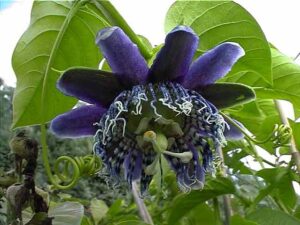
From Seedlings and Transplanting
Typically, seedlings will have reached about six to eight inches in height after four to six weeks and should be moved directly into the ground where the plant will be undisturbed.
Passionflower vines do not like to be transplanted after their taproots have developed.
They develop a large root ball and will need adequate space to spread, so choose a spot where the roots will not be in competition with other plants or trees, and where there is a suitable space for climbing.
Bear in mind that this vine can reach up to 30 feet in length, so it definitely needs its own place in the garden.
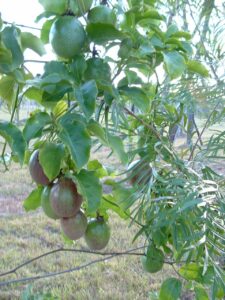
Prepare a hole that is at least twice the width of the seedling and at least as deep as the pot the plant is growing in.
Remove the seedling from the pot, being careful not to touch or damage the roots. They’re extremely sensitive, and root damage can easily kill the vine.
Place the seedling into the hole, filling loosely until secure, and water to settle.
If transplanting an older, more established vine, be sure that the entire taproot and root ball has been extracted with the plant.
This can be tricky, since roots can run several feet deep in the ground.
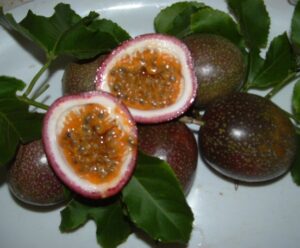
For mature vines, transplanting should take place in a cooler season before new growth has started, such as late winter or early spring.
Extract the plant from its location carefully, and be sure that the root ball and tap root are as intact as possible. Keep roots protected with a tarp until you’re ready to plant.
Prepare a hole that is several inches wider and deeper than the root ball. Replant and backfill with soil, tamping lightly, and water to settle.
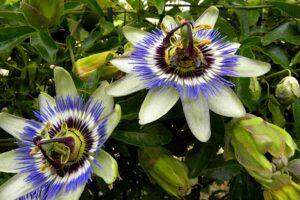
Be sure to provide a trellis or other support, as this vine is not self-supporting.
As mentioned previously, mature plants do not always respond well to transplanting, and you may notice some wilting or die off of vegetation at first. Applying some aged manure, compost, or fertilizer may help to perk the plant up until the roots are reestablished.
How to Grow
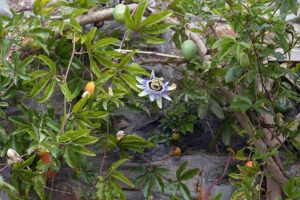
Passionflower prefers a temperate climate and high humidity of 60 to 85 percent on average.
As a vine, it also requires plenty of support, and adequate room to climb and spread.
Choose a location with full sun exposure and protection from overcrowding, such as along a fence or trellis, rather than near trees or other plants.
Be sure to watch for new vine growth, as runners can appear eight to 10 feet – or more – from the parent plant.
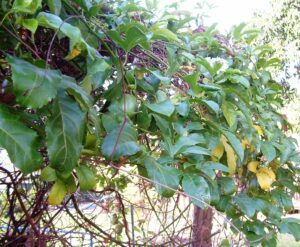
Soil at the planting site should be loose and deep, and adding composted organic material is a good idea, to encourage plant health from the beginning.
Passionflower prefers moist – but not wet – soil with good drainage. Offer approximately one inch of water per week, or as often as necessary to keep soil from drying out.
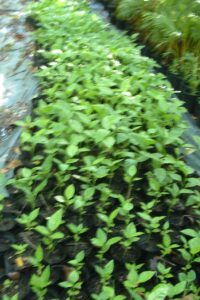
Standing water will increase the chances of root rot, which can kill the plant.
Fertilizer can be used as needed in a recommended ratio of 10-5-20 (NPK). Bear in mind that excessive nitrogen in the soil will promote foliage growth rather than blooms or fruit.
At times of the year when temperatures will dip below 32°F, applying a two-inch-thick layer of mulch at the base of the vine can protect against root damage that could kill the plant.
While pruning is not absolutely necessary, it can help to keep overgrowth in check.
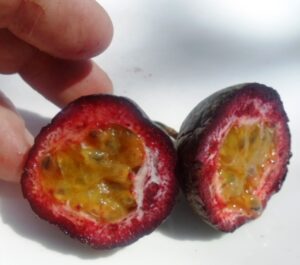
Lightly pruning new growth throughout the early growing season will encourage branching and redirect energy to producing blooms and fruit. Pruned cuttings can also be used to root new plants.
Air circulation is important for passionflower, particularly when fruiting, as inadequate airflow can cause molding and kill vegetation. Pruning to thin the vine can help to increase air circulation.
If you have trouble getting flowers to form, be sure to check out our guide, “7 Common Reasons Why Passionflower Fails to Bloom” for troubleshooting advice.
Growing Tips
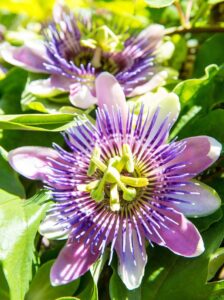
- Plant in full sun
- Protect from cold temperatures
- Allow adequate space and support for climbing and spreading
- Prune to manage growth
- Plant in loose soil with good drainage
- Amend with fertilizer as needed
- Avoid handling roots or transplanting if possible
Species to Select
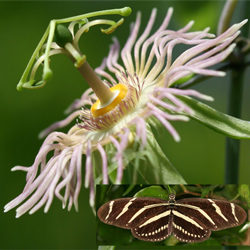
While their visual appeal is undeniable, many varieties of these vines also produce edible passion fruit.
Just remember that not all varieties produce edible fruit, so be sure to check when selecting a variety for your garden.
P. incarnata
The most popular species in North America is the purple passionflower, P. incarnata.
It is sometimes grafted onto rootstock to increase cold hardiness, and can often be grown further north, where winter temperatures are lower on average.
Edible fruit of this variety is sweet and musky, with a flavor similar to guava.
P. flavicarpa. I call it Hawaiian Gold
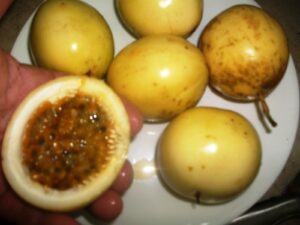
Another common species is P. flavicarpa, also called yellow passion fruit that produces a high yield of sweet, flavorful fruits that turn yellow when ripe.
The delicate yellowish-white petals are covered with a large dark purple corona.
P. caerulea
Blue passionflower, P. caerulea, is a good choice for midwestern US gardens, as this variety is hardy to Zone 8 with adequate water.
This species is known for its white petals and blue corona filaments, and deep orange fruits.
A winner of the Royal Horticultural Society’s Award of Garden merit, there are a number of cultivars available.
‘Constance Elliott’ has fragrant white flowers, ‘Chinensis’ sports delicate pale blue blossoms, and ‘Grandiflora’ has large, six-inch fragrant blooms.
‘Betty Miles Young’ is light purple, with dark purple filaments.
P. coccinea
Red passionflower, P. coccinea, produces bright scarlet flowers with white, purple, and yellow crowns.
This showy variety produces edible fruit that turns yellow when ripe.
‘Scarlet Flame’
P. mooreana
P. mooreana is great for gardeners who would prefer to grow their vine in a container, so it can be brought indoors during cold snaps.
Blooms have a strong, sweet fragrance. Delicate blue or white flowers with light blue filaments bloom from early summer to fall.
This smaller variety will still quickly overtake the space it inhabits if left unsupervised, but if pruned to the length of the support provided – such as a small trellis – it’s an excellent choice for fragrance, beauty, and edible fruit.
Managing Pests and Disease
Passionflower contains naturally occurring chemical substances called cyanogenic glycosides that prevent many insect pests from feasting, but the vine is still susceptible to disease.
Let’s take a look at some of the common maladies and afflictions that can befall this plant.
Herbivores
Few animals will disturb passionflower, however, those that do can cause quite a bit of damage.
Deer
Passion fruit is surrounded by a tough exterior that becomes shriveled and hard as it ripens.
This does not deter deer from munching on them from time to time, but planting in a protected area can prevent fruit from becoming dessert for Bambi.
Rabbits
In the home garden, rabbits often treat themselves to a buffet at your expense, and it is no different in this case.
As with deer, the best preventative measure is to keep the plants in a protected area.
Insects
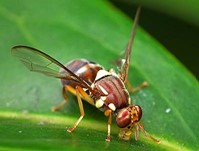
A variety of beneficial insects will visit blossoms throughout the growing season, which is a joy to behold. But there can be infestations of harmful pests as well.
Always consider the least environmentally damaging alternative when dealing with pests.
Aphids
These tiny, army-forming nuisances will devastate your garden, given the chance, so it is best to nip their residency in the bud as quickly as possible once they’re spotted.
Not only do they suck sap from vegetation, their indiscriminate consumption causes the spread of viral diseases between plants.
Find them under the flowers, gathered together in clusters, and along the stems.
Pay careful attention to your vines – if you see ants marching to and from your blooms, there may be aphids present as well, as the two have a mutually beneficial symbiotic relationship.
Ants farm aphids for “honeydew” (secreted droppings), and aphids depend upon ants for protection from predation.
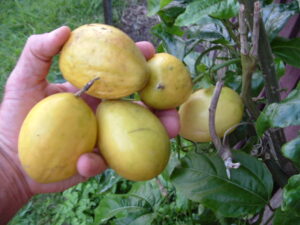
An excellent, natural way to combat this problem is to introduce ladybugs or a native species of praying mantis to your garden.
A blast of water from the garden hose can knock aphids from their position, but because of the ample hiding places available with this vine, this method may not remove all insects and can cause damage to blossoms.
Otherwise, the least damaging method of removal is donning a pair of gloves and squishing the aphids as you find them.
Read more about dealing with aphids in the garden here.
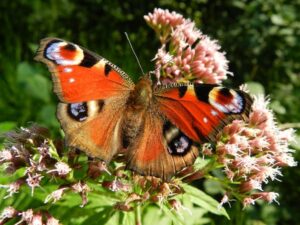
Gulf Fritillary Butterfly
Even though butterflies can hardly be considered a pest, caterpillars can cause some damage to plants as they munch insatiably on both leaves and blooms.
The Gulf fritillary or passion butterfly (Agraulis vanillae) rarely causes infestations, but a few may be found here and there.
While it can be annoying to see damage occurring as they prepare for cocooning, bear in mind that they are unlikely to kill the host plant. If damage becomes excessive, relocate them.
Disease
Viral and fungal diseases can afflict the passionflower vine, and unfortunately, some may not be easy to treat.
It is important to note that any time diseased parts of a plant are removed, any tools used should be thoroughly disinfected afterward to prevent accidental spread.
Dispose of infected plant material in the trash rather than adding it to your compost or leaving it elsewhere in the garden, as disease can be spread through the soil as well.
Potyvirus
This disease is also called passion fruit woodiness virus (PWV) and it is commonly spread by aphids.
Evidence of this disease to look out for includes mosaic symptoms on leaves, characterized by transparency and visible veining as leaves appear to be “bleached;” woody, deformed fruits; and stunted growth.
Treatment may include spraying with sodium hypochlorite; however, passionflower is intolerant of salt, and this type of treatment can also cause harm to the plant.
Mosaic Virus
There are several types of mosaic virus that may affect passionflower, and all cause similar damage such as spotting and mottling of leaves; distorted, curled leaves; and brittle vegetation.
Once again, this virus is spread by aphid infestation, so check for their presence to help combat further spread.
If only a few leaves are affected, remove and burn them, or dispose of them in the trash, away from other plants.
If the virus has spread further, prune away the affected parts of the plant.
Mosaic virus is easily spread. Keep vines that are growing in close proximity to others isolated by making sure that the foliage is not coming in contact with other plants or shared soil.
Harvesting
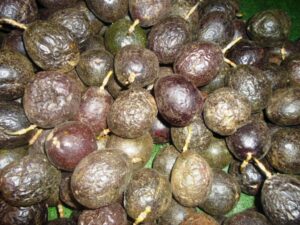
As the growing season moves along, blooms will transform into green fruits.
Most varieties of passionflower vine produce fruits the size and shape of a chicken egg, although some can be larger or more oblong.
The fruits will mature from bright green to a deep shade of purple, yellow, orange, or red, depending on the species.
As they ripen, they’ll begin to shrivel noticeably. Don’t worry! Even though the skin looks old and may even start to mildew, this is normal, and there is nothing wrong with the plant.
When fruits are ripe, their color deepens. Be sure to wait until they are fully ripened to pluck them from the vine, as green fruit will not continue to ripen once it’s picked.
Preserving and Culinary Use
The exterior of the fruit is tough with a thick layer of pith surrounding the interior pulp, and the entire rind should be discarded after extracting the pulp and seeds. It isn’t edible.
Passion fruit has a short shelf life of about one week, so be prepared to use them as soon as possible, either by eating fresh, preparing in a recipe, or scooping out the pulp and preserving it.
Pulp can be eaten directly from the fruit, seeds and all, or it can be strained and used in sauces and drinks.
The pulp can be processed into jelly, or pressure canned in a method similar to what would be used to make lemon curd.
Pulp can also be scooped out and frozen in an airtight container or zip-top bag for up to three months.
A Welcome Garden Addition, Whether for Fruit or Flowers
Welcoming the passionflower into your garden means enjoying an eye-catching, pollinator-friendly masterpiece year after year.
And as if this were not enough, this vine will reward with delicious fruit as well.
YES I HAVE PASSIONFRUIT VINE PLANTS & SEEDS FOR SALE
 Any questions or if buying, contact me HERE
Any questions or if buying, contact me HERE
![]()

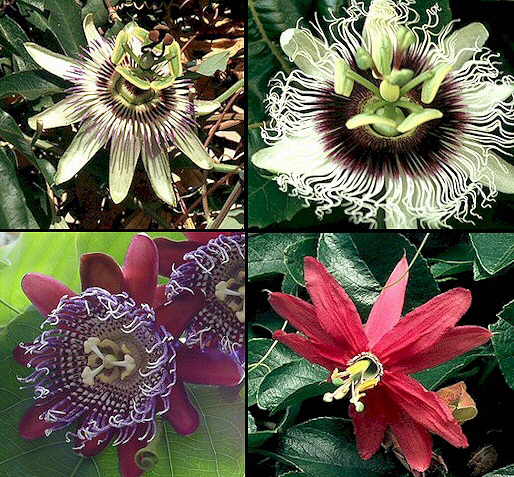
Recent Comments